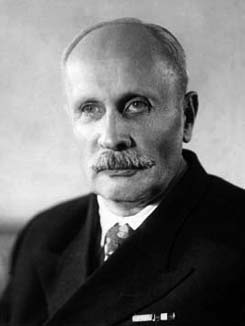


 تاريخ الرياضيات
تاريخ الرياضيات
 الرياضيات في الحضارات المختلفة
الرياضيات في الحضارات المختلفة 
 الرياضيات المتقطعة
الرياضيات المتقطعة
 الجبر
الجبر
 الهندسة
الهندسة 
 المعادلات التفاضلية و التكاملية
المعادلات التفاضلية و التكاملية 
 التحليل
التحليل
 علماء الرياضيات
علماء الرياضيات |
Read More
Date: 31-5-2017
Date: 31-5-2017
Date: 18-5-2017
|
Died: 21 May 1957 in Moscow, Russia

Aleksandr Nekrasov was educated in Moscow, attending the Fifth Moscow Gymnasium. His work at the school was outstanding and he was awarded the gold medal in 1901. In that year he entered the Faculty of Physics and Mathematics at Moscow University.
He graduated from the University of Moscow in 1906, receiving a first class diploma. He was awarded a gold medal for his essay on the Theory of the Satellites of Jupiter. At this stage he decided to aim at an academic appointment so he began working for his Master's Degree. However, to finance his studies he took a post as a secondary school teacher, working in several different schools in Moscow.
In fact Nekrasov worked for a Master's degree in both astronomy and mechanics and he qualified for these in 1909 and 1911. Appointed an assistant professor in the Department of Astronomy and Geodesy in 1912, he became an assistant professor in the Department of Theoretical Mechanics in the following year. He taught and undertook research in Moscow for the rest of his life but he did this at a number of different institutions. In addition to Moscow University he worked at the Higher Technical School, the Central Aerohydrodynamics Institute, the Sergo Orjonikidze Aviation Institute, and the Institute of Mechanics at the USSR Academy of Sciences.
The two scientists who most influenced Nekrasov most were Zhukovsky and Chaplygin. Zhukovsky had founded the Russian schools of hydromechanics and aeromechanics. He was known as the Father of Russian Aviation. Chaplygin, a student of Zhukovsky, wrote first on hydrodynamics under Zhukovsky's influence, in particular he worked on the mechanics of liquids and gases studying jet stream flow in the 1890s. Zhukovsky and Chaplygin set up the Central Aerohydrodynamic Institute in 1918 where Nekrasov worked. After Zhukovsky died in 1921 Chaplygin and Nekrasov continued to build on the foundations which he had put in place. As Grigorian writes in [1]:-
A fully worthy disciple of and successor to Zhukovsky, Nekrasov enriched Soviet science with his scientific works ...
Nekrasov published important work on the theory of waves, the theory of whirlpools, the theory of jet streams and gas dynamics. He also investigated mathematical questions which were related to these applications, in particular writing important works on non-linear integral equations. In fact his deep understanding of mathematical analysis as developed by mathematicians such as Goursat enabled him to succeed in solving a whole range of concrete problems. Grigorian writes in [1] that:-
Nekrasov was a brilliant representative of the trend in the development of precise mathematical methods in hydromechanics and aeromechanics...
He was awarded the N E Zhukovsky Prize in 1922 for his work On smooth-form waves on the surface of a heavy liquid. He was the author of an excellent two volume text on vector mechanics, the first volume being published in 1945 with the second in the following year. In 1947 he published a monograph on aerodynamics which set out the basic theory in a systematic way. In the same year another important work on the applications of integral equations to aerodynamics was published.
Several other works by Nekrasov were awarded prizes. He won the State Prize of the U.S.S.R. in 1951 for mainstream work on solving problems in hydromechanics. Elected to the USSR Academy of Sciences in 1932 he was also given the title of Honoured Worker in Science and Technology in 1947.
Books:
Articles:



|
|
|
|
لصحة القلب والأمعاء.. 8 أطعمة لا غنى عنها
|
|
|
|
|
|
|
حل سحري لخلايا البيروفسكايت الشمسية.. يرفع كفاءتها إلى 26%
|
|
|
|
|
|
|
في مدينة الهرمل اللبنانية.. وفد العتبة الحسينية المقدسة يستمر بإغاثة العوائل السورية المنكوبة
|
|
|